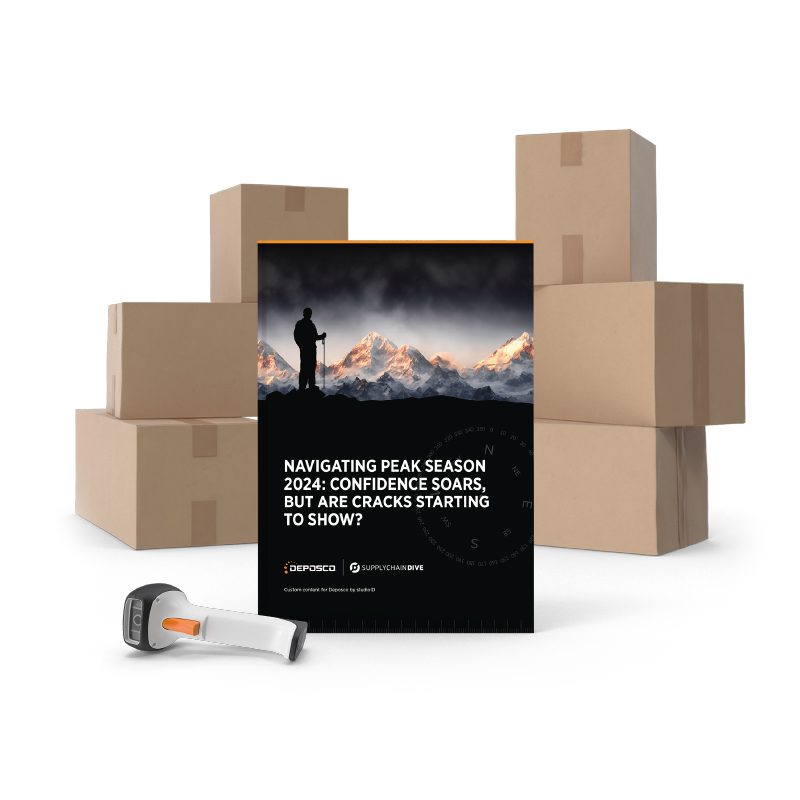Deposco’s annual Peak Season report with Supply Chain Dive tells us one thing, loud and clear: this year’s peak retail season will be harder than last year. Last year was worse than the year before. Every year is a reminder that the “Unknown” of picking and packing for peak retail is always a storm on the horizon.
READ THE 2024 PEAK SEASON REPORT for expert tips and predictions!
The consistent theme is that each Peak retail season will have more demand, less structure, and more picking and packing fires around every corner. Then our customers execute and say it wasn’t that bad. But who’s to say next year won’t be worse?
More picking and packing challenges are expected this peak retail season
But confidence runs high.
Interestingly, our customers are incredibly confident in Peak Season. While they don’t have much faith in the market, they do have confidence in their preparations:
- 77% of supply chain leaders anticipate Peak 2024 to be more challenging
- 70% say they are ‘very confident’ in their current system’s ability to handle picking and packing requirements during peak retail season
The biggest risk is the blind spots
A few things drive retailers’ confidence in peak preparations this year, but mostly in their staff, fundamentals, metrics, and fulfillment systems.
But you can’t ignore that there are blind spots in pick-pack-ship operations, as our report findings suggest.
The best part is that none of these are rooted in hype and are easily replicable by any business, given focus and will.
Here’s how to fix them.
Start by upskilling your pickers and packers
While we continue to hear that staffing is a problem, we also hear that people are the bedrock of any retailer’s peak pick, pack, and ship operations. Most retail supply chains are investing in their people.
When asked, “What role does a WMS play in your automation strategy?”, the number-one response was automating manual processes such as pick, pack, and ship (61%) – followed by improving speed and accuracy (55%), data collection (52%), and business intelligence and reporting (45%). Here are some of the ways retailers are upskilling their associates for a confident peak season:
- Improved performance and labor retention. Retailers are looking at digital upskilling to unlock picking and packing performance/retention in their teams. The more efficient their people are the fewer disruptions, and the less time it’ll take to identify and remediate when they do occur.
- MHE and automation. This includes deploying assistive WMS automation technologies, from enhanced flow pathing, batch picking, and multi-carrier shipping integrations on the system side to deploying wearables with AI-powered automation, ergonomics, and audio and visual cues to enhance their work experience. It has been proven that workers stay longer if they aren’t fighting the job while performing it.
- What worked, what didn’t? Sometimes, it’s also about figuring out what work didn’t need to be done. Looking at things like inventory slotting, flow paths in the warehouse, deploying some products to FBA, and other services can remove cumbersome work or slow a facility down. Rightsizing a building should include a review of the product assortment it holds.
- Rinse and repeat (where possible). The more that work can conform to a profile, over exceptions, the easier it is to speed up the seasonal fulfillment process without grinding your team.
Pick and pack fundamentals to ace your peak
Every major trade show will tell you that robots, drones, and mad science will fix your building and bring confidence to pick-pack-ship during your peak retail season.
At Deposo, we’ve seen several promising technologies that will move the supply chain forward. We’ve seen just as many that had us scratching our heads and asking, “Who is that for?”
Optimize warehouse space, first
Customer survey after customer survey tells us that optimizing your existing peak retail season processes is essential first. Similar to focusing on your staff’s skills and experience, you need to focus on the building itself.
- Consider your assortment. You can move some things to a third party, like FBA. Bulky or slow movers could be drop-shipped from the OEM. Ask yourself if, based on seasonal order patterns or ease of picking, packing, and processing, should this item be in your building?
- Consider your Slotting. Are you walking to different ends of the building to pick and pack an order? Some products are sold together frequently. An analysis of order history can tell you what should be shelved together.
- Consider your Velocity. Items that are picked frequently should be closer to the pack stations. With an estimated 50% of labor cost being travel and pathing, minimizing that represents a significant savings opportunity by doing an ABC segmentation to rearrange your inventory.
- Consider your Singles. Some things ship by themselves. It is a common peak retail practice to get those packaged by the manufacturer in a way that makes slap labels an option. If a cardboard box just needs a shipping label to go out the door, you can reduce picking and packing costs, along with processing time. Related: Explore all our AI-driven shipping management software designed to optimize processes and lower your costs
These are analytical solutions and the will and effort to reorganize the warehouse or facility. The net benefit is reducing movement and rework time in picking and packing – a major Lean waste that immediately improves productivity and worker experience, creating a confident Peak retail season.
Go Fast Technology
Lastly, put the warehouse management software in place that you need. And do it early.
One of the biggest concerns we’re seeing is that uncertainty in the market is driving a pullback on investment again. From interest rates to fears of softening consumer demand, necessary supply chain improvements aren’t being done. Learn more on that topic: Strategic fulfillment software vs. cost optimization project.
No matter how well you’ve addressed your people and your operations, the warehouse management systems that run it all will be a significant bottleneck to execution if they can’t handle your growth. No prep for tomorrow is complete if you are still using a system designed for a business half your size. And it’s just going to get worse the longer you put it off.
Luckily, swapping these operations systems has become incredibly modular with the popularity of cloud-native solutions. You can swap out components without taking the whole building down. It also means that you are no longer required to buy entire packages of software; you can deploy solutions dynamically when the need is met.
The additional benefit of a Saas WMS vs. on-premise means you aren’t doing an engineering project just to upgrade your systems. Most cloud solutions, like Deposco, will support the ability to quickly add resources to absorb any volume you throw at it.
If you’ve been putting off addressing gaps in your technology, or finally sunsetting that solution that no longer delivers, start immediately. You might have missed the window for this peak, but it’s never too late to make sure the next one isn’t “the worst year” of your career.
That’s the confidence our customers rely on. Need proof? Check out how Deposco customers said their peak went last year.
KPIs are the next crucial step
Learn how to put the right supply chain KPIs around the performance of your peak retail season.


